Choosing the right bike often starts with understanding its frame size. Whether you’re buying your first bicycle or upgrading to a new one, knowing how to measure your bike frame is crucial. This ensures you get a bike that fits you perfectly, making your rides comfortable and efficient, no matter if you’re hitting the road or tackling mountain trails.
Understanding bike frame measurements is equally important if you’re planning to rent a bike. Accurate measurements help you communicate your needs, ensuring your rental bike can be properly adjusted for a comfortable and enjoyable ride.
However, bike frame sizing isn’t always straightforward. Different manufacturers may use varying methods, which can be confusing. To truly compare bike frames and find the right fit, it’s essential to understand and measure key frame dimensions yourself.
This guide will walk you through the process of measuring your road bike or mountain bike frame. By understanding these measurements, you’ll be better equipped to choose the right bike size and achieve the optimal bike fit. For deeper insights into how these measurements impact handling, you can also explore our detailed guide on mountain bike geometry. While focused on mountain bikes, many principles apply to road bikes as well.
We also offer specific advice on selecting the correct frame size for road bikes and mountain bikes, along with guidance for choosing women’s bikes.
Key Bike Geometry Measurements Explained
Before we dive into the ‘how-to’, let’s clarify the essential bike geometry measurements you’ll be working with. These measurements define the frame’s dimensions and significantly influence the bike’s feel and performance:
- Top Tube Length (Effective): This is the horizontal distance from the center of the head tube to the center of the seatpost. It’s a critical measurement for reach and overall bike fit.
- Seat Tube Length: Measured from the center of the bottom bracket to the top of the seat tube, this length often dictates frame size, though less consistently now.
- Reach: Reach is the horizontal distance between the bottom bracket and the top of the head tube. It’s a key factor in determining the bike’s cockpit length and rider position.
- Stack: The vertical distance from the bottom bracket to the top of the head tube. Stack height influences handlebar height and rider posture.
- Wheelbase: The distance between the front and rear wheel axles. Wheelbase affects stability and handling.
- Chainstay Length: The length from the center of the bottom bracket to the rear axle. Chainstay length impacts the bike’s responsiveness and climbing ability.
- Front Center: The distance from the center of the bottom bracket to the front axle. Front center influences weight distribution and handling.
- Seat Tube Angle: The angle of the seat tube relative to the ground. This angle affects pedaling efficiency and rider position over the pedals.
- Head Tube Angle: The angle of the head tube relative to the ground. Head tube angle is crucial for steering responsiveness and stability.
- Bottom Bracket Drop: The vertical distance the bottom bracket sits below the wheel axles. Bottom bracket drop affects stability and cornering.
- Bottom Bracket Height: The distance from the ground to the center of the bottom bracket. Bottom bracket height influences ground clearance and center of gravity.
Tools for Measuring Your Bike Frame
To accurately measure your bike frame, you’ll need a few simple tools. Gathering these beforehand will make the process smoother and more precise:
- Tape Measure: Essential for measuring lengths in metric units (centimeters or millimeters are recommended for accuracy).
- Clinometer (or Smartphone App): Used to measure angles. Many free clinometer apps are available for smartphones, making angle measurement accessible.
- Spirit Level (or Straight Edge with Clinometer App): A long spirit level ensures horizontal and vertical measurements. Alternatively, a straight piece of wood combined with a clinometer app can serve the same purpose.
- Plumb Line (or String and Weight): A plumb line helps establish a vertical reference. You can easily improvise one using a piece of string and a small weight like Blu Tack or a nut.
While most modern bikes, whether road or mountain, use metric measurements, some manufacturers, particularly for mountain bikes, might still use inches. Brands like Moots even combine both systems. For consistency and ease of measurement, we strongly recommend using metric units throughout the process. If needed, converting centimeters to inches is straightforward by dividing by 2.54.
Before you start measuring, it’s worth checking the manufacturer’s website for a geometry chart specific to your bike model and size. If your bike is a current model, this chart will likely provide more precise measurements than you can obtain manually and serves as a valuable reference point.
Measuring Top Tube Length Effectively
 Demonstration of top tube measurement on a bicycle frame
Demonstration of top tube measurement on a bicycle frame
Historically, bike top tubes were predominantly horizontal. Today, many bikes feature sloping top tubes. While geometry charts often list the ‘real’ top tube length, for consistent sizing comparisons, the effective top tube length (or virtual top tube) is more useful.
The effective top tube length is the horizontal distance between the center of the head tube and the center of the seatpost. To measure it accurately:
- Locate the center of your head tube and seatpost. These are your starting and ending points.
- Use your spirit level or clinometer app to ensure a perfectly horizontal measurement. This is crucial for accuracy, especially with sloping top tubes.
- Measure the horizontal distance between these two center points. This measurement gives you the effective top tube length.
Many road bike manufacturers use top tube length as a primary sizing metric. However, mountain bikes, and increasingly road bikes too, often use S, M, L sizing. It’s important to note that these size designations can vary significantly between brands. For instance, a size S frame from Ridley might have a top tube length around 54cm, which could be considered a medium by another brand.
Even when comparing virtual top tube lengths, be aware that measurement methods can differ slightly between manufacturers. Colnago, for example, measures horizontally from the head tube to a vertical projection from the top of the seat tube, which doesn’t account for seatpost setback. This means a Colnago with a ’50s’ size might equate to a 54cm top tube from another brand.
Measuring Seat Tube Length Accurately
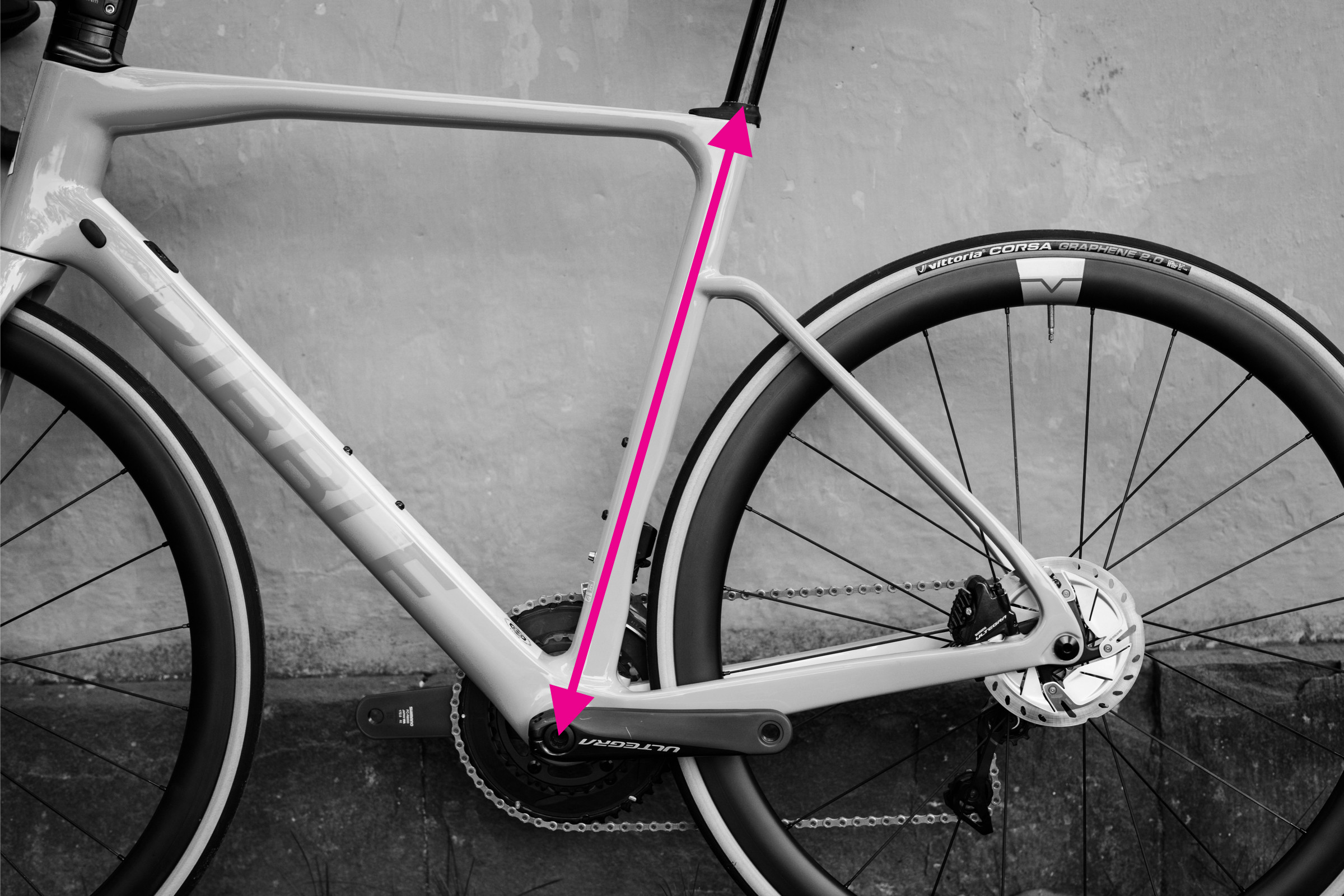 Demonstration of seat tube measurement on a bicycle frame
Demonstration of seat tube measurement on a bicycle frame
Seat tube length is measured as the straight-line distance from the center of the bottom bracket to the top of the seat tube. While seemingly straightforward, certain frame designs can complicate this measurement.
Bikes like the Trek Madone have extended seat tubes above the top tube junction, while others use seatmasts, making direct comparisons challenging. Mountain bikes often feature kinks in the seat tube, so measuring along the tube itself will yield an inaccurate, longer measurement.
To measure seat tube length correctly:
- Identify the center of the bottom bracket and the top of the seat tube.
- Use a straight edge to create a direct line between these two points. This is especially important for bikes with seat tube kinks.
- Measure the straight-line distance along this line. This gives you the accurate seat tube length.
Measuring Reach and Stack for Bike Fit
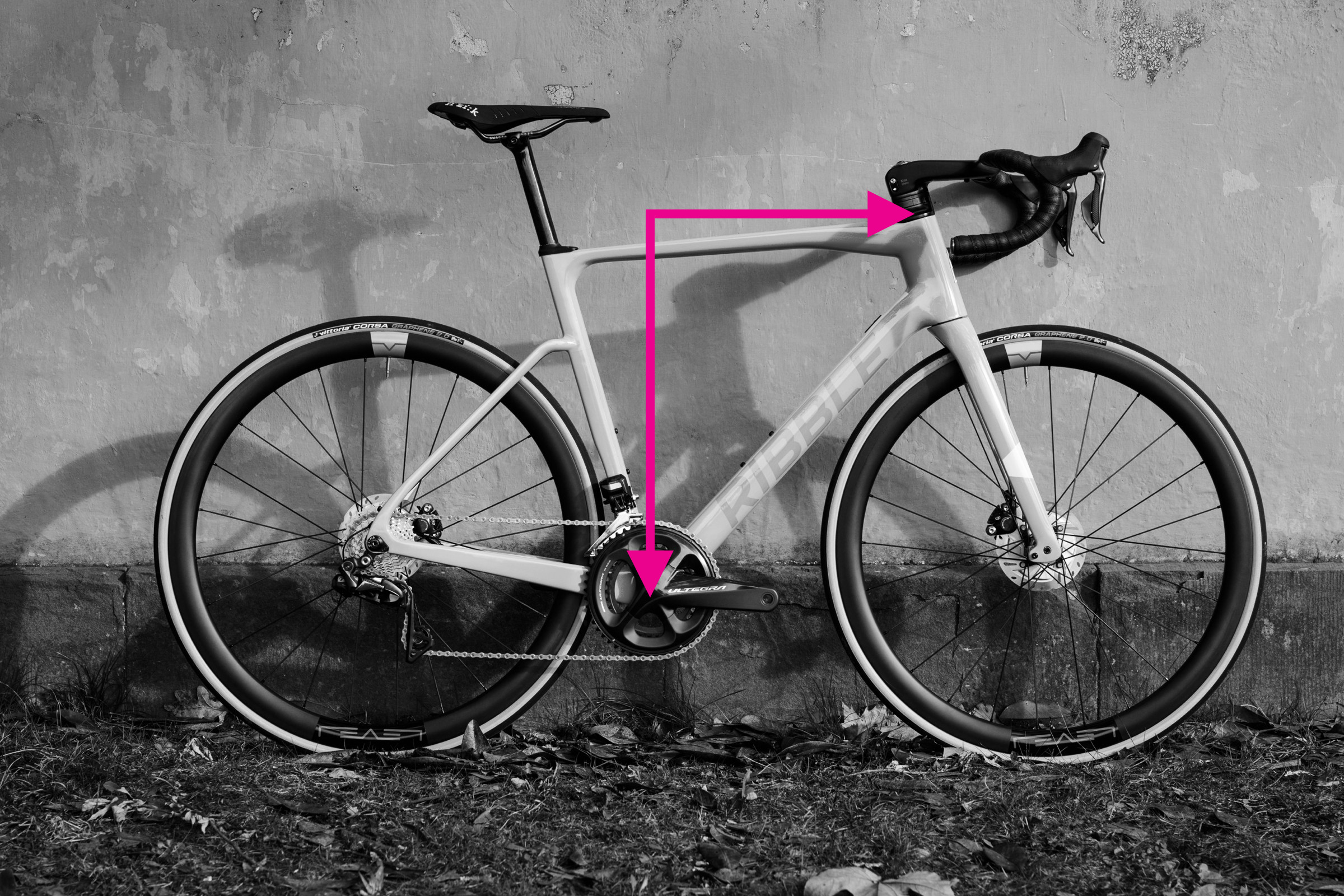 Demonstration of stack and reach measurements on a bicycle frame
Demonstration of stack and reach measurements on a bicycle frame
Reach and stack have become increasingly important measurements for comparing bike frames, offering more consistency than top tube and seat tube lengths. They are independent of frame angles and directly relate to rider fit. Reach and stack measure the perpendicular distances between the bottom bracket and the top of the head tube, two critical contact points for the rider.
For a detailed explanation of the importance of reach and stack, refer to our article on why top tube length is less relevant.
Measuring Reach (Horizontal Distance):
- Set up your spirit level and plumb line. Attach the plumb line securely to one end of the level. Ensure the weight at the end of the string is stable and hangs straight down for accurate vertical reference.
- Align the top edge of the level with the centerline of the top of the head tube.
- Adjust the level horizontally until the plumb line intersects precisely with the center of the bottom bracket spindle.
- Measure the horizontal distance from the top of the plumb line to the head tube. This distance is your bike’s reach.
An alternative method for reach measurement involves positioning your bike against a wall, measuring the horizontal distances from the wall to the top of the head tube and the bottom bracket, and then subtracting the latter from the former. Ensure all measurements are accurately horizontal.
Measuring Stack (Vertical Distance):
- Once you have your setup for reach measurement (spirit level and plumb line), the vertical distance from the bottom bracket to the spirit level aligned with the top of the head tube represents the stack. Follow the plumb line vertically upwards from the bottom bracket to the level.
- Measure this vertical distance. This is your bike’s stack.
Another way to measure stack is to measure the vertical distance from the ground to the top of the head tube, then measure the bottom bracket height from the ground, and subtract the bottom bracket height from the head tube height.
Measuring reach and stack can be tricky and may require a second person to assist, especially when using the plumb line method. Repeating measurements helps ensure consistency and accuracy.
Measuring Wheelbase for Ride Quality
 Demonstration of wheelbase measurement on a bicycle frame
Demonstration of wheelbase measurement on a bicycle frame
Wheelbase, the distance between the front and rear axles, is a key determinant of a bike frame’s ride quality. It also varies with frame size. A longer wheelbase generally provides more stability, while a shorter wheelbase can make the bike feel more agile.
To measure wheelbase:
- Ensure the front fork is pointing straight ahead. Misalignment will lead to inaccurate measurements.
- Measure the distance between the front and rear axle centers.
- Repeat the measurement on both sides of the bike and take the average. This compensates for any slight fork misalignment and improves accuracy.
Measuring Chainstay Length for Handling
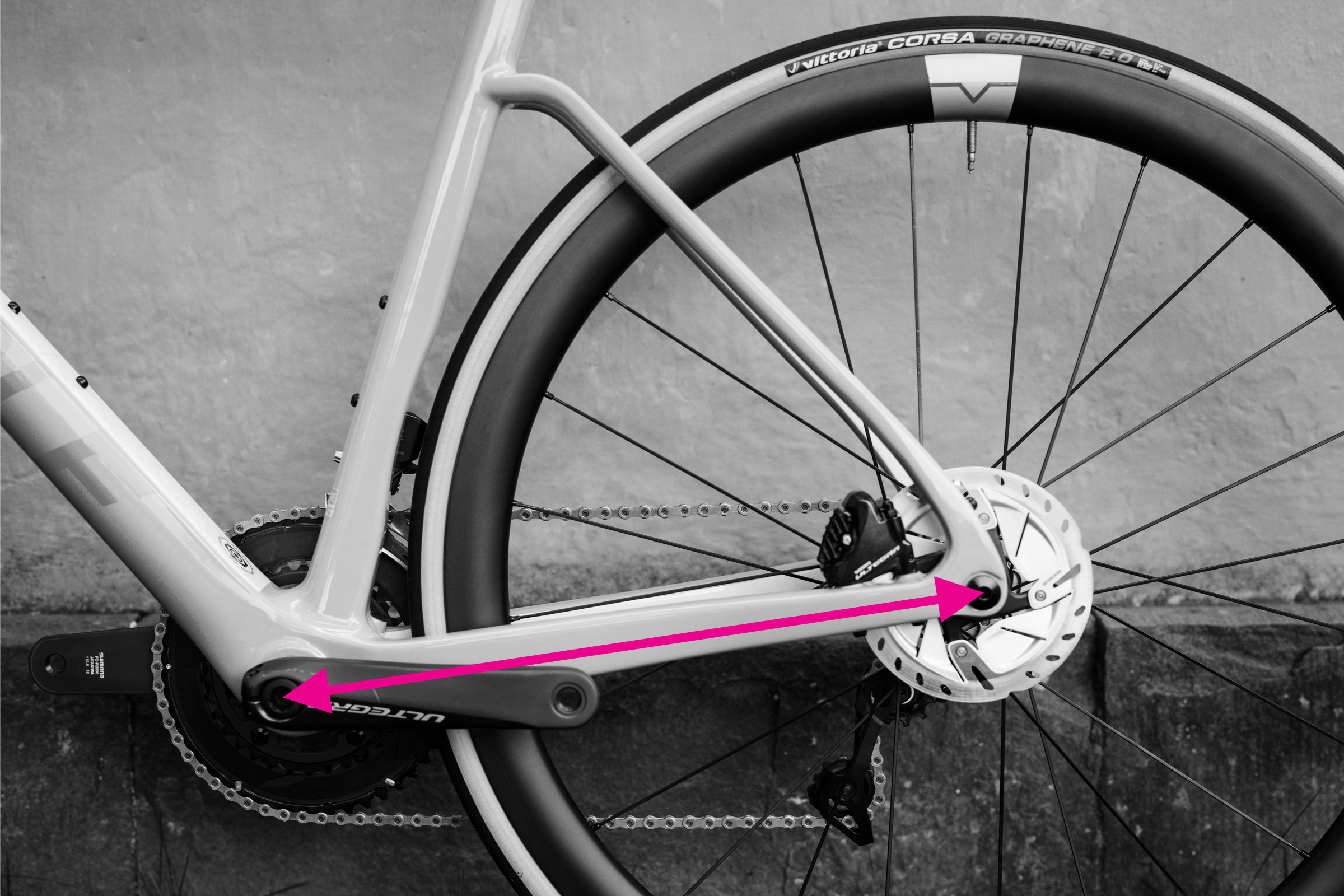 Demonstration of chainstay length measurement on a bicycle frame
Demonstration of chainstay length measurement on a bicycle frame
Chainstay length is a component of the wheelbase and significantly influences a bike’s handling characteristics. Shorter chainstays typically result in a more responsive and lively feel, often preferred for climbing and quick maneuvers. Longer chainstays can enhance stability, particularly at higher speeds.
Measuring chainstay length is relatively simple:
- Locate the center of the bottom bracket axle and the center of the rear dropout.
- Measure the straight-line distance between these two points using a ruler or tape measure. This is your chainstay length.
Measuring Front Center for Balance
 Demonstration of front center measurement on a bicycle frame
Demonstration of front center measurement on a bicycle frame
Front center is the other component of the wheelbase, analogous to chainstay length but measured to the front dropout. It influences handling and factors into toe overlap (the possibility of your shoe hitting the front wheel during sharp turns). Although less commonly listed than other measurements, some manufacturers like BMC include it in their geometry charts.
To measure front center:
- Identify the center of the bottom bracket axle and the center of the front dropout.
- Measure the straight-line distance between these points. This gives you the front center measurement.
Note that the wheelbase is not simply the sum of chainstay length and front center because these measurements are not taken horizontally; they are straight-line distances along the frame’s tubes.
Measuring Seat Tube and Head Tube Angles
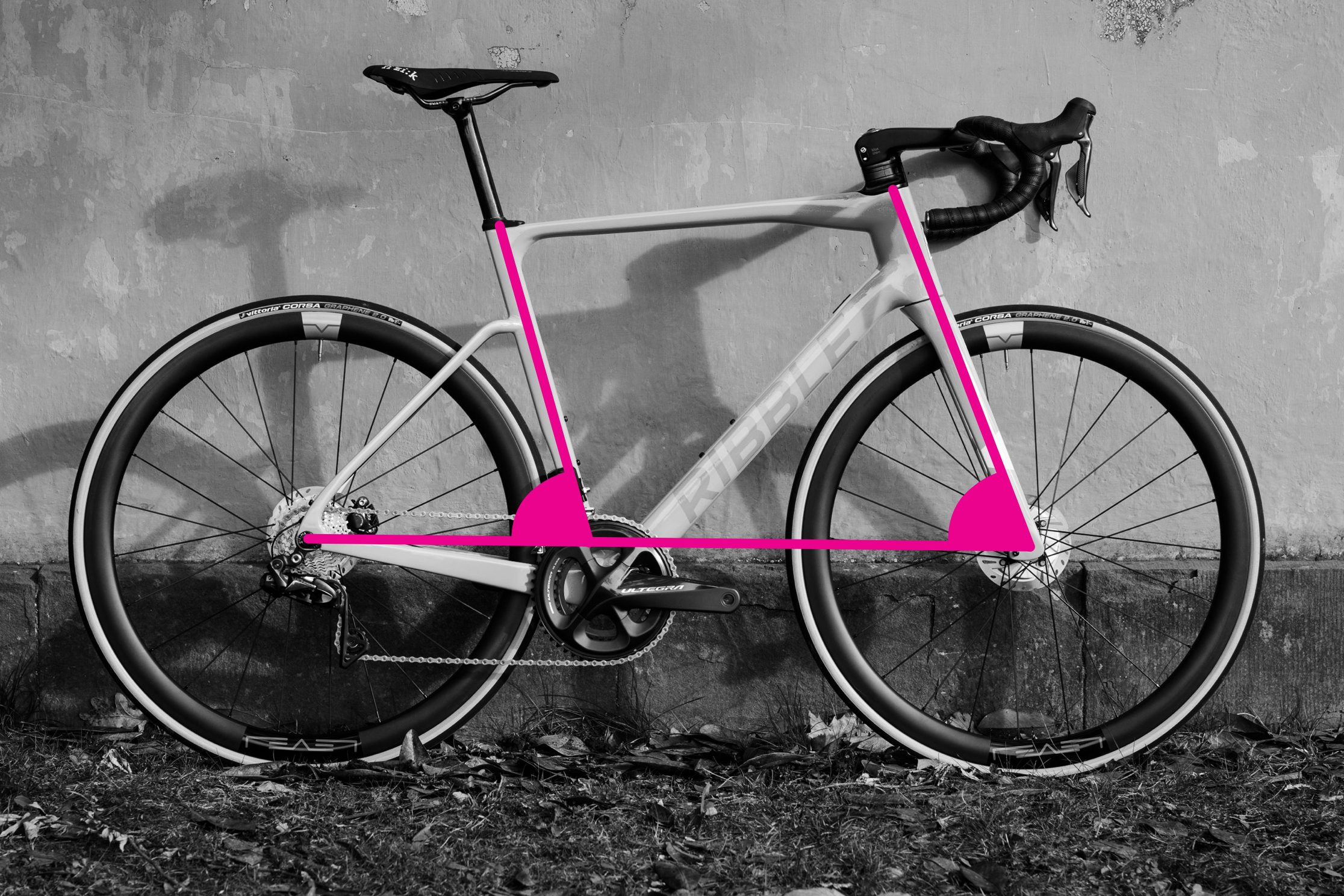 Demonstration of seat tube and head tube angle measurements on a bicycle frame
Demonstration of seat tube and head tube angle measurements on a bicycle frame
Seat tube and head tube angles are critical factors in determining a bike’s handling. Steeper angles (closer to 90 degrees) generally lead to quicker, more nimble handling, while slacker angles provide more stability, especially at speed. Your clinometer app is essential for measuring these angles.
Measuring Seat Tube Angle:
- If your seat tube is straight, align your smartphone (with the clinometer app active) directly against the seat tube.
- Ensure your bike is vertical and on level ground for an accurate reading. The clinometer app will display the angle.
- If your seat tube has a kink, use a straight edge to span from the bottom bracket shell to the top of the seat tube. Then, align your phone against this straight edge to measure the angle.
Measuring Head Tube Angle:
- Modern bikes often have tapered head tubes, meaning the angle of the front surface may differ from the centerline angle. To measure the centerline angle, try to align your phone with the estimated centerline.
- Alternatively, use a straight edge to connect the centers of the top and bottom of the head tube, and measure the angle against this edge.
- For bikes with straight fork legs (without a crown angle), you can measure the angle of the fork legs as a proxy for the head tube angle.
- Another method is to align the clinometer with the steerer tube extension above the head tube.
- Again, ensure the bike is vertical for accurate angle measurements.
Measuring Bottom Bracket Drop for Stability
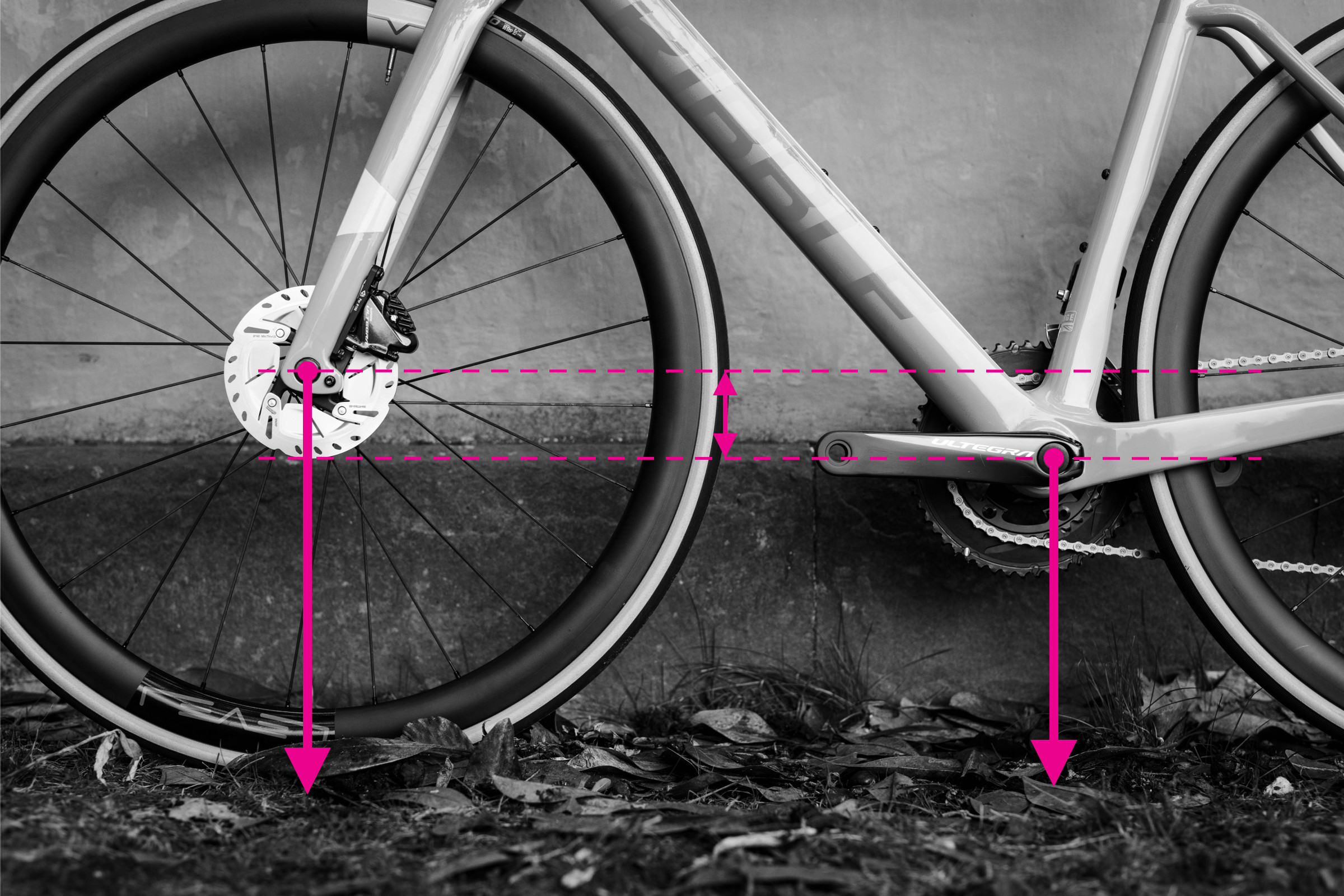 Demonstration of bottom bracket drop measurement on a bicycle frame
Demonstration of bottom bracket drop measurement on a bicycle frame
Bottom bracket drop is the vertical distance that the bottom bracket sits below the horizontal line connecting the wheel axles. A larger bottom bracket drop generally lowers the bike’s center of gravity, enhancing stability, especially at higher speeds and in corners.
To measure bottom bracket drop:
- Measure the height from the ground to the rear axle center.
- Measure the height from the ground to the bottom bracket center.
- Subtract the bottom bracket height from the axle height. The result is the bottom bracket drop.
Measuring Bottom Bracket Height for Clearance
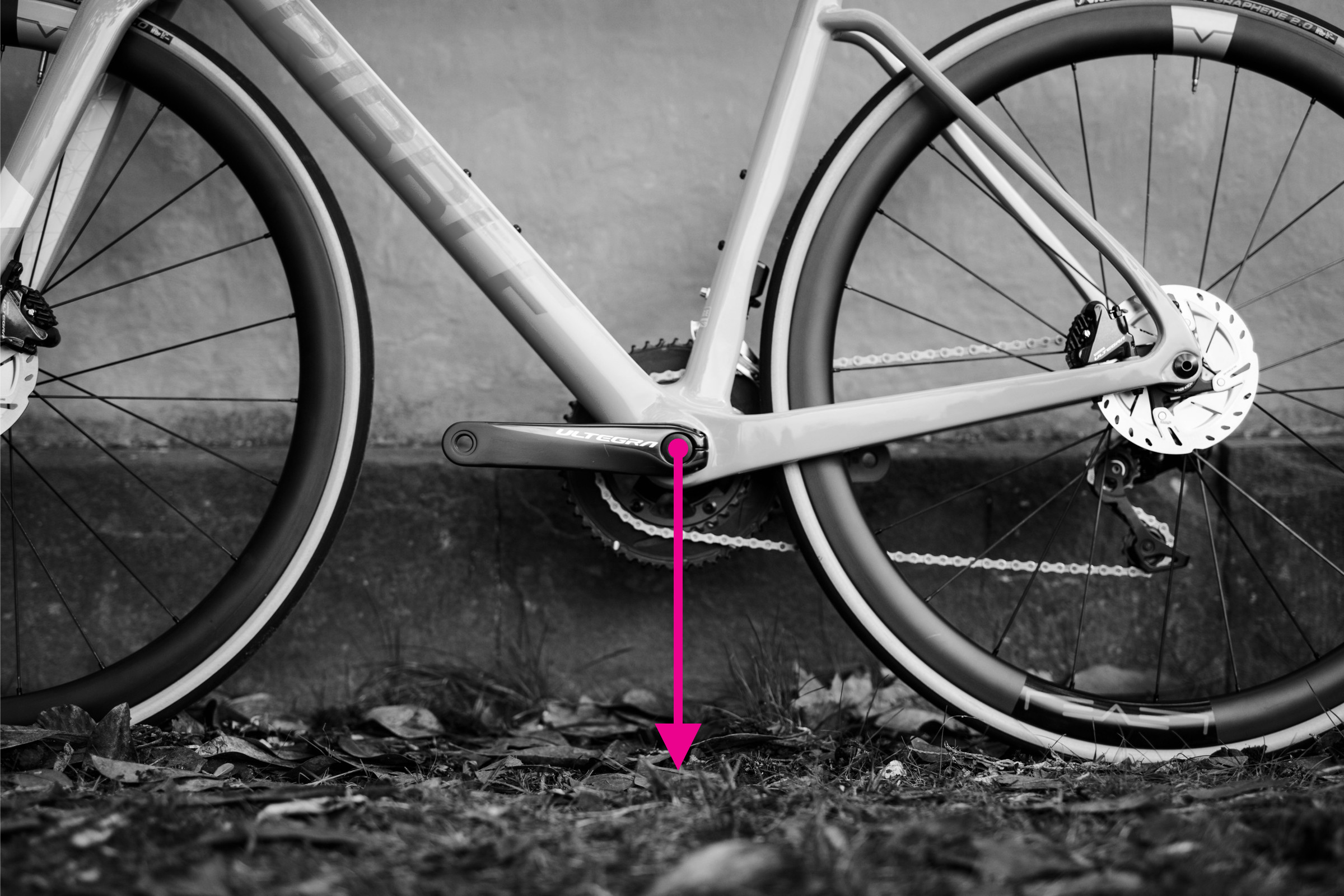 Demonstration of bottom bracket height measurement on a bicycle frame
Demonstration of bottom bracket height measurement on a bicycle frame
Bottom bracket height is simply the distance from the ground to the center of the bottom bracket shell. This measurement is important for determining ground clearance – higher bottom bracket heights offer more clearance for obstacles, which is particularly relevant for mountain biking and off-road cycling.
Measuring bottom bracket height is straightforward:
- Measure the vertical distance from the ground to the center of the bottom bracket shell.
- Ensure your bike is upright and on level ground for an accurate measurement.
- Slightly inflate your tires to your typical riding pressure before measuring, as tire pressure can subtly affect bottom bracket height.
With these measurements in hand, you are now equipped to understand and compare bike frame sizes effectively. Whether you’re considering a new purchase, exploring second-hand road bikes, choosing a commuting bike, or selecting a gravel bike, these measurements will be invaluable in making informed decisions. Keep your measurements recorded in a safe place for future reference!
